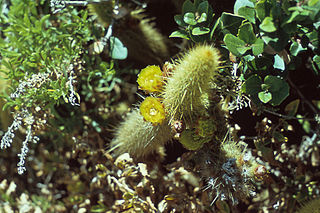
Bergerocactus emoryi is a species of cactus. It is the sole member of the genus Bergerocactus, named after Alwin Berger. The plant is also known as snake cactus, though this latter name also applies to Echinocereus pensilis.
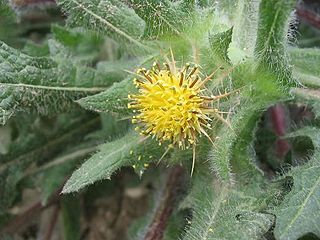
Cnicus benedictus, is a thistle-like plant in the family Asteraceae, native to the Mediterranean region, from Portugal north to southern France and east to Iran. It is known in other parts of the world, including parts of North America, as an introduced species and often a noxious weed. It is the sole species in the monotypic genus Cnicus. Other species once included in the genus have largely been reclassified to Cirsium, Carduus, and Centaurea.
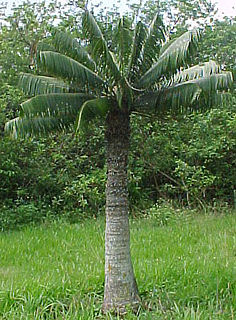
Microcycas is a genus of cycads in the family Zamiaceae containing only one species, Microcycas calocoma, endemic to a small area in western Cuba in Pinar del Río Province.

Echinopsis spachiana, commonly known as the golden torch, (white) torch cactus or golden column, is a species of cactus native to South America. Previously known as Trichocereus spachianus for many years, it is commonly cultivated as a pot or rockery plant worldwide. It has a columnar habit, with a lime-green cylindrical body with 1–2 cm long golden spines.
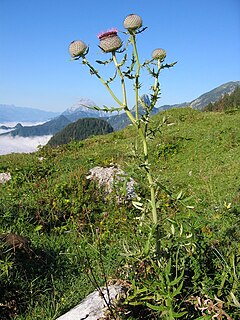
Cirsium eriophorum, the woolly thistle, is a herbaceous biennial species of the genus Cirsium. It is widespread across much of Europe. It is a large, biennial herb with sharp spines on the tips of the leaves, and long, woolly hairs on much of the herbage. Flower heads are large and nearly spherical, with spines on the outside and many purple disc florets but no ray florets.

Parodia buiningii is a rare species of cactus native to South America. It is a solitary spherical or oblate cactus only a few inches in height with long, yellow spines. It bears yellow flowers, and produces hairy fruit and black seeds. It is found surrounding the towns of Santana do Livramento, Brazil and Rivera, Uruguay.

Parodia leninghausii is a species of South American cactus commonly found as a houseplant. Common names include Lemon Ball cactus, Golden Ball cactus and Yellow Tower cactus.

Lophocereus marginatus is a species of plant in the family Cactaceae. It is sometimes called Mexican fencepost cactus. It has columnar trunks that grow slowly to 12 feet and may reach 20 feet in height. Stems are 3 to 4 inches (9–10 cm) in diameter, with ribs 5 to 7 in (13–18 cm). Its central spine is about 3/8 inch (1 cm) in diameter with five to 9 radials and slightly yellowish in color. Its cuttings are sometimes used to create fences, as its spines are not as large or dangerous as some cacti.

Parodia tenuicylindrica is a species of cactus from the genus Parodia. The small green cacti have yellow and red-brown spines, white wool and yellow flowers. They produce yellow-green fruit, and black seeds. P. tenuicylindrica can be found growing individually in Rio Grande do Sul, Brazil.

Parodia arnostiana is a species of cactus in the genus Parodia. The small, squat green plants produce yellow flowers, green fruit and black seeds. The species is found growing in Rio Grande do Sul, Brazil.

Austrocactus coxii is a plant species in the genus Austrocactus from the cactus family (Cactaceae), indigenous to southern Argentina and southern Chile. It grows as short columnar stems up to 5 cm diameter, reaching 60 cm in height, with 6-10 tuberculate ribs. Central spines are hard, straight or slightly hooked, light brown to whitish and up to 4 cm long. Thin spines are interwoven and range from 6 to 10 in number; each is up to 1 cm long. Its diurnal red flowers are up to 3.5 cm in diameter.

Ferocactus emoryi, known commonly as Emory's barrel cactus, Coville's barrel cactus and traveler's friend, is a barrel cactus in the genus Ferocactus.

Gymnocalycium anisitsii is a globular cactus belonging to the family Cactaceae. The specific epithet honors the Hungarian pharmacist Dániel Anisits J. (1856-1911).

Parodia schumanniana is a quite rare species of succulent plant in the family Cactaceae. The specific epithet schumanniana honors the cactus specialist Karl Moritz Schumann.

Agave xylonacantha is a plant species native to Hidalgo, Tamaulipas, Guanajuato and Queretaro in Mexico, but commonly cultivated as an ornamental on other regions. A. xylonacantha is an easy-to-grow member of the genus Agave.

Echinopsis terscheckii, commonly known as the cardon grande cactus or Argentine saguaro, is a large cactus native to South America and popular in cultivation.

Parodia scopa, the silver ball cactus, is a species of flowering plant in the cactus family Cactaceae, native to upland southern Brazil and Uruguay. It is a ball- or cylinder-shaped cactus growing to 5–50 cm (2–20 in) tall by 10 cm (4 in) broad, with a spiny, woolly crown and pale yellow flowers in summer.

Parodia ottonis, also known as Indian head cactus, is a cactus found in Argentina, Brazil, Paraguay and Uruguay. There are two recognized subspecies. The epithet ottonis honors the German botanist Christoph Friedrich Otto.
Encephalartos dyerianus is a species of cycad in Limpopo, South Africa.
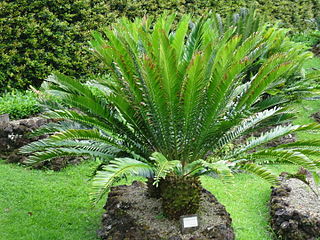
Encephalartos msinganus is a species of cycad from Kwazulu-Natal.






















